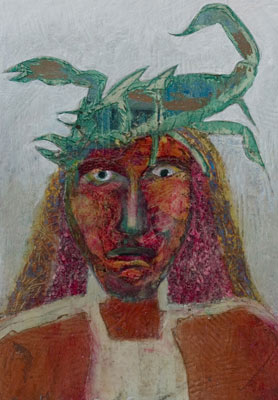Patrick Bartz’s Sixteen at Art Resources
Santa Barbara Painter's Work Shows through March 28
Broad, bold simplicity is the first impression one gets from these recent works by native Santa Barbara painter Patrick Bartz. Like so many first impressions, it’s correct and incorrect in equal measure. While the images Art Resources has assembled for Sixteen-and, yes, there are 16 of them-do thrust their subjects straight to the center of attention, they’re also subtle. In most of these paintings, eye-catching figures are foreground, front-and-center, yet they are described with delicate techniques and framed by a vision of nature that’s as layered as it is lucid.

Take “Cooper’s White Fisher,” a large work dominated by a stark white bird, its wings fully outstretched, or “Seated Nude,” a straightforward, distraction-free view of just that. The latter is a rare example of human intrusion into the show’s primarily animal and vegetable world; Bartz’s heart appears to be much more in the depiction of nature undisturbed by human presence. When mankind does to appear, its representatives tend to merge with the nonhuman life forms in decidedly unnatural ways: The subject of “Angry Art Teacher” appears to be mostly a vehicle for the scorpion riding atop its head, while the languid figure slouching across “Cactus and Bird Decide on Symbiosis” has allowed an array of cactus blossoms and a bird-friendly perch to sprout from its arm. It’s easy to see which biological forms are the bosses here.
A trio of smaller paintings, “Rainbird,” “Golf,” and “Tennis,” capture the intersection of the natural and the manmade in what one might call domesticated landscapes; an athletic track cutting a swath through the grass, for instance, or an unexpectedly mesmerizing view of a lawn sprinkler frozen in the middle of its wide, watery arc. These scenes are realistically rendered, relatively speaking, but they possess the same thickly textured quality as the thirteen other pieces, which combine painted surfaces bearing the look of stone or sand with unconventional color choices: green hides, orange faces, teal limbs. In Sixteen, man and nature take turns as dominator and dominated, and who will triumph depends on how you view it.



